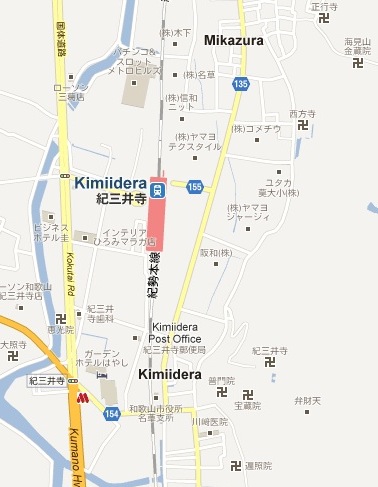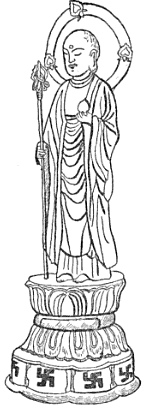https://villagehiker.com/travel/travel-japan/swastika-in-japan-vh-jn-02.html
The Swastika in Japan (卍)
Japanese maps display hundreds of swastikas.
by Bob Kerstetter
Japanese maps display hundreds of swastikas. You also see them elsewhere—not everywhere, but elsewhere—on decorative containers, fans and building edifices, as examples.
 A swastika consists of two equal length lines perpendicular to each other and aligned at their centers. Half the distances from their centers to their ends the lines bend at right angles, all in the same direction to the left or to the right.
A swastika consists of two equal length lines perpendicular to each other and aligned at their centers. Half the distances from their centers to their ends the lines bend at right angles, all in the same direction to the left or to the right.
In modern western experience, the swastika represents the hatred and violence of the Nazi party. In the 1920s, the German Nazis adopted the swastika as their symbol. After the party gained power in the 1930s the swastika became the emblem of Germany. To those outside the Third Reich the swastika soon signified humanity at its worst. The Nazis rotated the swastika 45°. The angled ends of the Nazi swastika pointed to the right.
 From their beginnings in India, swastikas meant be well, be good in your higher being and other healthy things. Even the Nazis understood this, but as Aryan superiority.
From their beginnings in India, swastikas meant be well, be good in your higher being and other healthy things. Even the Nazis understood this, but as Aryan superiority.
 As adapted by Buddhism, one of the major faiths rooted in India, the swastika symbolized eternity. The Buddhist meaning of the swastika traveled from India to China to Japan.
As adapted by Buddhism, one of the major faiths rooted in India, the swastika symbolized eternity. The Buddhist meaning of the swastika traveled from India to China to Japan.
On maps of Japan, swastikas mark the locations of Buddhist temples. The angled ends of the Buddhist swastikas point to the left or to the right. There is no rotation. There is no tie between Japanese Buddhism and Nazism.
Japanese pronounce their word for swastika as manji. They write the word in at least three ways:
- 卍
- 卍字
- 万字
There may be more ways.
Sources
The swastika, the earliest known symbol, and its migrations by Thomas Wilson (free Google eBook)
Google Map of Kimiidera Area of Wakayama, Japan
